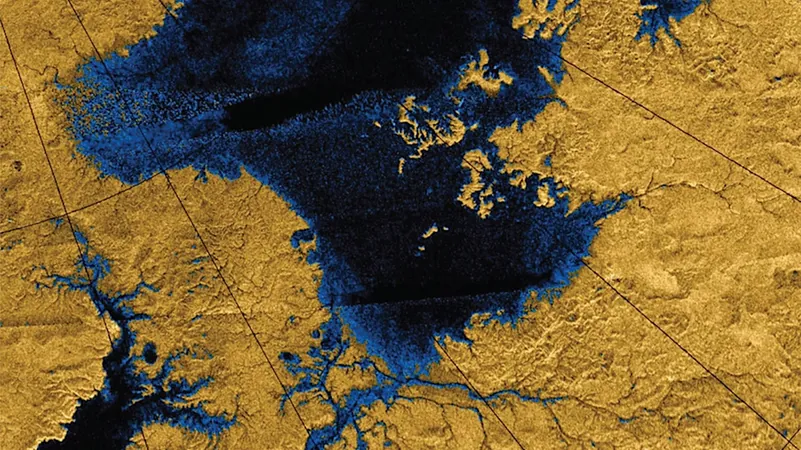
The Enigma of Titan’s Missing Deltas: What’s Happening?
2025-04-19
Author: Li
Unlocking the Secrets of Deltas on Titan
When it comes to piecing together the geological history of celestial bodies, river deltas are a goldmine of information. They capture sediment that unveils ancient climates, tectonic movements, and even hints of past life. This is one reason NASA targeted Mars' Jezero Crater, which boasts a stunningly preserved delta for exploration.
But now, eyes have turned to Titan, Saturn’s largest moon and a unique world that features rivers of liquid methane—similar to Earth’s flowing water. Scientists anticipated finding deltas here too, but they are alarmed by a startling discovery: Titan appears to be mostly devoid of them.
What’s Behind the Delta Drought?
"As a geomorphologist, it's quite disappointing," lamented Sam Birch, an assistant professor at Brown University and the study's lead author. "Deltas should serve as records of Titan's geological and climatic history, yet they seem shockingly absent." The lack of deltas raises new questions about Titan's surface processes. Birch mused, "We usually assume rivers and sediments equate to deltas. But Titan challenges everything we think we know, making it a fascinating mystery to explore."
A World Like No Other
Titan is a strange, Earth-like wonder, featuring a dense atmosphere filled with nitrogen and methane, creating clouds, winds, and even rain. Yet, instead of water bodies, its unique landscape boasts lakes and rivers of liquid methane and ethane, existing thanks to the moon's frigid temperatures.
The thrilling discovery of these liquid bodies came courtesy of NASA's Cassini spacecraft in 2006, which peered through Titan's thick haze with synthetic aperture radar (SAR). While the images revealed spider-like channels and vast areas resembling seas, the absence of deltas, even at the mouths of rivers, raised eyebrows.
A New Approach to Unravel the Mystery
Was the lack of observable deltas a flaw in the data, or were they genuinely missing? Birch and his team launched a study to clarify the issue, published in the Journal of Geophysical Research: Planets. Their approach involved a clever numerical model simulating how Cassini's SAR would capture Earth's landscapes if they were composed of Titan's liquid methane.
Birch explained, "We created synthetic SAR images of Earth, replacing its water with Titan’s methane. This allows us to understand what we might be missing on Titan." More familiar landscapes, like the U.S. Gulf Coast, could reveal deltas if they existed.
The Shocking Findings
Despite the promising outlook, Birch's team found that Titan is even more delta-free than expected. With only two possible deltas identified near the south pole, they observed a mere 1.3% of Titan's rivers end with deltas—a stark contrast to Earth, where nearly every similarly-sized river showcases extensive delta systems.
What’s Going On?
So why does Titan lack these crucial features? Birch speculates a few theories. The fluid dynamics of Titan’s rivers should allow for sediment transport, but rapid sea level changes may quickly erase delta formations before they can establish. Additionally, strong winds and tides could further disrupt delta development.
The mysteries don’t end with the missing deltas. The team also discovered unexpected pits in Titan's lakes and intricate chasms carved into sea floors—questions that remain unanswered.
An Evolving Mystery
Birch concludes, "This is far from what we anticipated. But that’s the allure of Titan—its ability to continually confound our expectations makes it a captivating subject for scientific inquiry." Prepare for more revelations about this enigmatic moon!



 Brasil (PT)
Brasil (PT)
 Canada (EN)
Canada (EN)
 Chile (ES)
Chile (ES)
 Česko (CS)
Česko (CS)
 대한민국 (KO)
대한민국 (KO)
 España (ES)
España (ES)
 France (FR)
France (FR)
 Hong Kong (EN)
Hong Kong (EN)
 Italia (IT)
Italia (IT)
 日本 (JA)
日本 (JA)
 Magyarország (HU)
Magyarország (HU)
 Norge (NO)
Norge (NO)
 Polska (PL)
Polska (PL)
 Schweiz (DE)
Schweiz (DE)
 Singapore (EN)
Singapore (EN)
 Sverige (SV)
Sverige (SV)
 Suomi (FI)
Suomi (FI)
 Türkiye (TR)
Türkiye (TR)
 الإمارات العربية المتحدة (AR)
الإمارات العربية المتحدة (AR)